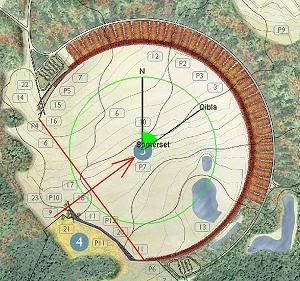It was cool, but not cold. The skies were beckoning. Four aircraft sat fueled, waiting for the turbines to crank.
89 jumpers, two of them camera “flyers,” milled about, discussing the 5 jumps yesterday, or other things, or the upcoming jump, while sorting through gear bags and extracting various pieces of “business equipment.”
With the smell of the kerosene based jet fuel exhaust in the air, sometime around 9AM, the geared up jumpers climbed into their assigned aircraft for the lift to 15,000 ft AGL (which, being on the banks of the York River, was effectively MSL, too).
They taxied, some nodding off, some already asleep, despite the din of the high pitched jet engines with propellers attached, some shifted to see out the nearest door or window to watch the ground pass by enroute the runway. Finally, off the ground they went, the Super Casa, two Twin Otters and a Beech King Air.
Jump run was roughly south, with the 5 minute and 2 minute standby to jump signals were radioed between pilots and yelled at the occupants of the cargo areas. We rose, feeling the connection points of our harnesses, pushing the pilot chutes into their pack or leg mounted containers, careful to make sure the attached hackey sack was still protruding for easy gripping at the moment needed later on.
Shuffling into positions, doors opening, “floaters” carefully getting their grips and placing their toes on door frames before swinging outside of the cabins, all eyes, from any vantage point in the trailing three planes, on the rear ramp of the Super Casa in the lead of the four ship “V”, with the King Air aft and starboard to make the “V” look more like a check mark.
In the Super Casa, at 15,000 feet over West Point, VA airport: “READY! SET!!!!! (the photographer lets go and gets big) GOOOOOOOOO!!!!!!” and the bodies give into gravity, followed instantly by those “stacked” further forward. Cascades of humanity from three other planes join the “base,” eyes seeking the expected color pattern of jumpsuits and rigs as briefed and seen on the ground. Subtle and not so subtle movements begin as people move to their assigned quadrants, facilitated by the placement in the various aircraft, to minimize the possibility of collisions. The floaters from the Casa, who had been hanging on the side of the door frame by their hands, legs bent at the knees inboard to avoid the airstream outside of the shape of the boxy fuselage, hover above and aft of the formation on the line of flight, ready to pounce their “slots” when they see the base stable out.
“Divers” aggressively close the small, fast falling formation, moving to within feet of where their position will appear, if all goes as planned. Those from the other planes are all in this category, maneuvering quickly to a quadrant, then checking to see how to refine their position relative to the base, and to keep a straight, clear line of flight when it’s their turn.
Meanwhile, within the “base,” which includes “The Queen,” (that’s Carol Clay’s nickname, not a formation position), and Larry Pennington (read the linked post..his name is there), along with some big boys, who, not only will fall fast because of their size, but also because of their demonstrated discipline to not relax their arch and let the core slow down. They have to keep the base falling “down the pipe” (straight down), faster than the average freefall speed and on heading, as the rest of those inbound to their slots can’t be sliding around the sky all day to get to a target location moving in several dimensions simultaneously.
People are bleeding off speed in their transition from a delta body position to a modified “frog” body position. If you watch closely, you can discern the waves working in towards the base, people a few feet apart, “sheep dogging” their slots. The base grows quickly, as successive rings of jumpers find their grip points and attach themselves. The photographers drastically change their fall rate, going “low” to get upward looking shots, then spreading the wing area under their arms to slow and get back above the formation to get other angles.
My slot is now there. The other edge of the formation a few feet away from where I have been lurking since diving out of the King Air, with only three others coming out behind me. A fast dive, while sliding laterally to my quadrant and then to about the 4:30 position of the formation, followed by a flare and a relatively fast belly to earth fall position. I move forward and reach with my left hand for my single grip on the right knee of the jumper. I failed to keep my symetry and bobble a bit. I drop about a foot below the formation as a result, then flatten out my arm and get back up, now being within the proper distance to take my grip. I am in. A few more of the total of 87 jumpers enter and I get to look across the backs of those in front of me to the other side of the basically circular formation and notice lots of smiles.
It is not time to relax. We still have to keep our attention to the small trends in fall rate we note, using those around us as a reference, and quickly anticipate the the changes in body position we need to take to keep the formation flat and intact.
11 seconds. No waves of differing fall rates rolling across the bodies, resulting in a crack the whip like effect on the opposite side. The record. We only needed to hold it for 3 seconds, with everyone in the planned place. We got it together high enough to enjoy an extra 8 seconds of flying a “big way.”
At 5000 feet, the base begins to kick their legs, signaling the departure of the first wave of us on the outer rings of the formation. We will track away, and wait until 2500 feet to open our canopies. Subsequent groups leave in 500 foot increments, and will pull at 500 foot higher altitudes, to give each wave two dimensions, at a minimum, of separation. The base group stays together for a few more seconds, then tracks apart and opens at 2500 feet.
What next? Clear your airspace below (the low person has the right of way) and open at the assigned altitude. Commence hooting and hollering once you have a good canopy, head for a safe area to land, clearing other canopies as you need to.
Head back to the clubhouse, toss your gear on the packing mat and commence to congratulate those who did it. Smile with huge grin.
Find Sandy Wambach and tell her thanks for all her prep work to make this happen. Sandy, sadly is gone, but she was a special lady who just loved jumping and getting others together to do really big things. This was but one of many, many efforts she undertook for the love of the sport and the love of fun.
I think the record for largest formation for the state still stands.
I would have had some video clips, but have to capture them off the DVD recording from the original VHS tape. So far, my video editing software isn’t gonna cooperate, but one day…maybe the evidence will be here.
The next best part? The rest of the day to “fun jump” with lots of very experienced jumpers from all over the country.











